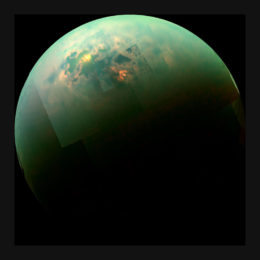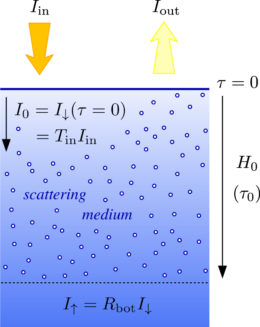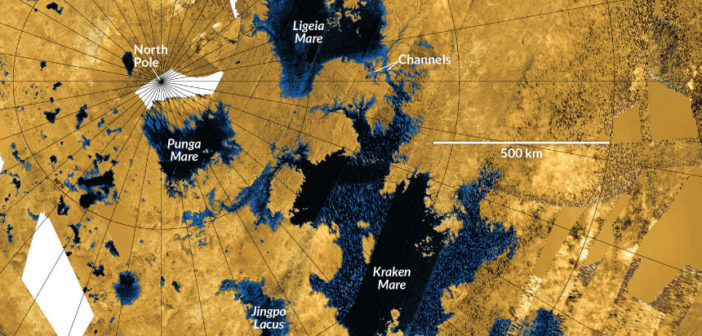The frigid seas of Titan, Saturn’s largest moon, host a secret: something is causing features to appear and disappear within them. Could these seas be bubbling? And if so, how could such bubbles form and grow?
Frigid Seas

Near-infrared mosaic showing sunlight reflecting off of Titan’s north polar hydrocarbon seas. [NASA/JPL-Caltech/University of Arizona/University of Idaho]
Titan is a hostile, chilly world, with a nitrogen atmosphere and an icy crust. Its distance from the Sun is roughly ten times the Earth–Sun distance, so Titan’s surface temperatures are only around 95 K (–290 °F). At this temperature, hydrocarbons methane and ethane take liquid form, pooling in pockets in Titan’s crust to form hundreds of hydrocarbon lakes and seas that dot Titan’s surface.

Evolution of transient bright features — “magic islands” — in Ligeia Mare, as seen by radar images. Click for a better look. [NASA/JPL-Caltech/ASI/Cornell]
Magic Islands
In the past few years, scientists have noticed something odd about one of these seas, the northern Ligeia Mare: radar observations of Titan’s surface have shown bright regions within the sea that appear and vanish from one flyby to the next. In acknowledgement of these features’ mysteriousness, scientists nicknamed them “magic islands”.
What could be causing these transient features? One of the more popular explanations is that streams of bubbles are being released as atmospheric nitrogen — originally dissolved in the liquid methane and ethane of the sea — separates out and rises to the surface.
Now, two scientists from the University of Reims Champagne-Ardenne in France, Daniel Cordier and Gérard Liger-Belair, want to understand whether such bubbles could even form in the unique environment of Titan’s seas.
Growing Bubbles from the Seafloor
Cordier and Liger-Belair start their study from what we know: if the “magic islands” are, in fact, bubbles, then they must be at least ~2cm in size near the surface of Ligeia Mare; if they were any smaller, they wouldn’t reflect the radar waves. The authors then use theoretical calculations and simulations to explore ways to form and grow bubbles to this size in a hydrocarbon sea.

Authors’ sketch of a column of bubbles within Titan’s liquid methane/ethane seas. Radar waves come in from above and reflect off of the bubbles. [Cordier & Liger-Belair 2018]
The authors show that the best explanation for large bubbles at Ligeia Mare’s surface is that bubbles form or are released tens of meters down at the seabed and then rise as a vertical column. As the bubbles bump into each other and combine within this plume, they arrive at the sea’s surface at a potential size perfect for reflecting radar waves.
Cordier and Liger-Belair’s work shows that nitrogen bubbles in a methane and ethane sea could indeed explain the “magic islands” we only discovered after three centuries of studying Titan. Who knows what we’ll learn in the next three centuries observing this mysterious moon!
Citation
Daniel Cordier and Gérard Liger-Belair 2018 ApJ 859 26. doi:10.3847/1538-4357/aabc10


4 Comments
Pingback: I gelidi mari di Titano nascondono un mistero: oceani "effervescenti", enigma per la luna di Saturno - Meteo Web
Pingback: I mari di Titano sono “frizzanti” – La Macchina del Tempo
Pingback: Burbujas en los mares de Titán – Observatori Astronòmic
Pingback: Burbujas en los mares de Titán « SEDA / LIADA - RedLIADA - Cursos LIADA - Cielo del Mes - Fenómenos Astronómicos - RELEA